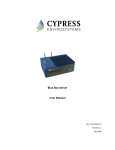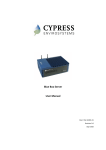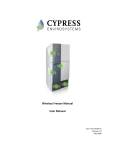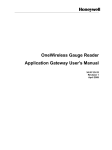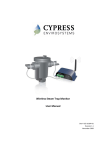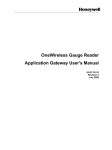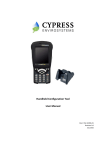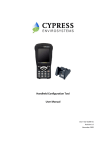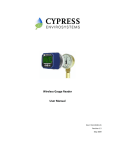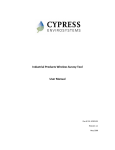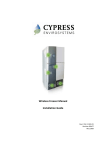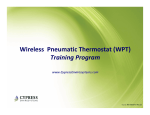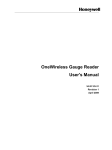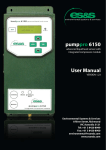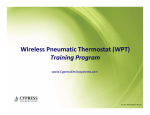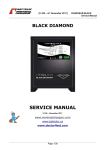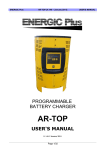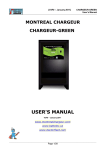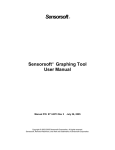Download Blue Box Server User Manual For BETA Software 4.0
Transcript
Blue Box Server User Manual For BETA Software 4.0 Doc # 152-10201-01 Revision DRAFT November 2009 Copyrights Copyright 2008 by Cypress Envirosystems. All rights reserved. The information in this document is subject to change without notice. While reasonable precautions have been taken, Cypress Envirosystems assumes no responsibility for any errors that may appear in this document. No part of this document may be copied or reproduced in any form or by any means without the prior written consent of Cypress Envirosystems. Disclaimer CYPRESS ENVIROSYSTEMS MAKES NO WARRANTY OF ANY KIND, EXPRESS OR IMPLIED, WITH REGARD TO THIS MATERIAL, INCLUDING, BUT NOT LIMITED TO, THE IMPLIED WARRANTIES OF MERCHANTABILITY AND FITNESS FOR A PARTICULAR PURPOSE. Cypress Envirosystems reserves the right to make changes without further notice to the materials described herein. Cypress Envirosystems does not assume any liability arising out of the application or use of any product or information described herein. Cypress Envirosystems does not authorize its products for use in mission or safety critical systems or where a malfunction or failure may reasonably be expected to result in significant injury to the user. The inclusion of Cypress Envirosystems’ product in mission or safety critical system applications implies that the manufacturer assumes all risk of such use and in doing so indemnifies Cypress Envirosystems against all charges. In no event is Cypress Envirosystems liable to anyone for any indirect, special or consequential damages. Table of Contents 1.0 2.0 3.0 4.0 5.0 6.0 7.0 8.0 9.0 10.0 11.0 Introduction ........................................................................................................................ 4 Safety Precautions .............................................................................................................. 4 Description of BBS............................................................................................................... 4 3.1 Cypress Envirosystems Monitoring System.............................................................. 5 3.2 Related Products....................................................................................................... 5 Setup Instructions ............................................................................................................... 6 4.1 Components.............................................................................................................. 6 Web Console ....................................................................................................................... 7 5.1 Starting the Program and General Navigation ......................................................... 7 5.2 Readings Page ........................................................................................................... 7 5.3 Other Readings Pages ............................................................................................... 9 5.4 Configuring Nodes................................................................................................... 10 5.5 Battery and Signal Strength Status ......................................................................... 15 5.6 Setting up the Alarm ............................................................................................... 15 5.7 View Alarm History ................................................................................................. 17 5.8 Querying the System Remotely .............................................................................. 19 5.9 Graphs ..................................................................................................................... 19 5.10 Using Tables to Export Data.................................................................................... 21 OPC Interface .................................................................................................................... 23 Care and Maintenance...................................................................................................... 23 Troubleshooting................................................................................................................ 23 Technical Specifications .................................................................................................... 24 Support.............................................................................................................................. 24 Warranty Information....................................................................................................... 24 Cypress Envirosystems Doc # 152-10201-01 Rev DRAFT BBS User Manual Page 3 1.0 Introduction Thank you for purchasing the Cypress Envirosystems Blue Box Server (BBS), a core component of the Cypress Envirosystems Monitoring System. Please read this manual thoroughly before using the BBS. 2.0 Safety Precautions • • Do not expose the BBS to water. Do not try to repair yourself as it contains no user-serviceable parts. Contact a qualified service technician for repairs. See Section 10.0, Support, for details. 3.0 Description of BBS The Cypress Envirosystems Blue Box Server, BBS, is a flexible industrial server that collects wireless data from various Cypress Envirosystems field devices and enables access to the readings from a variety of user interfaces. The BBS can be used as part of an overall existing infrastructure or as a stand alone station. Figure 1. Blue Box Server Through industry standard protocols, the data collected on the BBS can be connected to existing plant systems. The data can also be viewed from any computer on the intranet using a standard web browser. Cypress Envirosystems Doc # 152-10201-01 Rev DRAFT BBS User Manual Page 4 3.1 Cypress Envirosystems Monitoring System The Cypress Envirosystems Blue Box Server is part of the Cypress Envirosystems Monitoring System. This system can be setup one of two ways: Figure 2. Cypress Envirosystems Monitoring System Setup Options For users with existing plant databases and operator stations, the BBS can forward data seamlessly integrating with existing plant SCADA or IT infrastructure. This can be accomplished using a variety of open communication protocols (e.g. OPC, BACnet, web services). This configuration is depicted in Figure 2 as Option A. For users who do not need to connect to an existing infrastructure, the BBS can also serve as a standalone Web Server and Text Message Server, shown in Figure 2 as Option B. Standard PC workstations can become operator stations simply by using any standard web browser. Alarm notifications can be sent via email or SMS to cell phones. 3.2 Related Products Blue Box Servers can be used to communicate to and collect data from the following Cypress Envirosystems field devices: • Wireless Gauge Readers (WGRs) • Wireless Transducer Readers (WTRs) • Wireless Steam Trap Monitors (WSTMs) • Wireless Freezer Monitors (WFMs) • Wireless Battery Monitors (WBMs) • Wireless Range Extenders (WREs) Cypress Envirosystems Doc # 152-10201-01 Rev DRAFT BBS User Manual Page 5 4.0 Setup Instructions 4.1 Components The BBS comes with the following components: BBS Antennas Power Cord Connect the antennas to the back of the BBS as shown in Figure 3. Then connect the power cord. To turn on the BBS press the rocker switch highlighted in Figure 3. Power switch Figure 3. BBS Power Switch Location To change the receiver channel frequency, set the DIP switches accordingly. Frequency Dip Switches -Channel Set A (2,74) -Channel Set B (6,78) -Channel Set C (24,50) -Channel Set D (30,54) Figure 4. BBS Channel Frequency Configuration Cypress Envirosystems Doc # 152-10201-01 Rev DRAFT BBS User Manual Page 6 5.0 Web Console The Cypress Envirosystems Web Console is a browser-based program that enables a user to remotely monitor, configure, and review data from Cypress Envirosystems wireless field devices. This section explains how to read and edit data points, set up alerts and notifications, and graph and export data. 5.1 Starting the Program and General Navigation To start the Cypress Envirosystems Web Console, open a Web browser, type in the IP address or name of the Blue Box Server, and click Enter. The application opens by default to the READINGS page, which provides a summary of every data point, or node, in the system. A Main Menu bar is located at the top of every page in the application with tabs that enable users to navigate through the different pages in the program. The BBS may be set up to receive data from multiple types of Cypress Envirosystems field devices. If multiple device types are configured, the various field devices will have separate READINGS pages. See Figure 5 below. Figure 5. Cypress Envirosystems Web Console Main Menu Bar Also on the top of every page is the Alarm Status button, as shown in Figure 6. The button is green if all node readings are within alarm limits. It turns red when a node reading has slipped above or below the preset alarm thresholds. (Read Section 5.6, Setting Up the Alarm, for more information on how to set up notifications and reset the alarm status.) By clicking on the Alarm Status button, users can view the alarm history and reset the alarms. 5.2 Readings Page The READINGS page displays a summary of all node readings. The page also provides other detailed information, such as the time of the reading, as well as the upper and lower control limits and the status of a particular node. Figure 6 shows a sample READINGS page. Cypress Envirosystems Doc # 152-10201-01 Rev DRAFT BBS User Manual Page 7 Figure 6. WGR and WTR READINGS page 5.2.1 Get Node Readings To check node readings, click on READINGS in the Main Menu. The READINGS page appears with the following information: • • • • • • • • Timestamp: Time when the last reading was taken. This time is based on the BBS system clock. NodeID: Identification number that your service representative originally assigned to a node. Description: A brief description of the node, for example, “Emergency Generator” or “Water Inlet Pressure.” Reading: The most recent reading taken from the node. Your service representative configures the update rate when the system is installed. Units: Unit of measurement that applies to the reading. LCL: Lower control limit. When a node reading falls below this value, the system signals an alert. (See Section 5.6, Setting Up the Alarm) UCL: Upper control limit. When a node reading rises above this value, the system signals an alert. (See Section 5.6, Setting Up the Alarm) Status: Indicates the status of the node, for example, whether it is okay, inactive, or below or above acceptable limits. Values are: OK, Inactive, Error, Lower Ctl Limit, Upper Ctl Limit. Cypress Envirosystems Doc # 152-10201-01 Rev DRAFT BBS User Manual Page 8 Based on the status, individual rows are also highlighted to provide an extra visual cue. Table 1 provides a detailed description of each status and the highlighted color. Row Color None Indication OK Red Error Blue Inactive Gray No Data Verify Yellow Low Battery Orange Upper Ctl Limit Lower Ctl Limit Description The node is functioning normally. This is the default status of the node. An error message is reported by field device, indicating that the field device could not obtain a reading. The field device has stopped sending data to the BBS. The field device has been configured on the BBS, but no data has ever been sent from that field device. Node readings have not changed in past 2 days. By default this feature is disabled. To enable this feature contact Cypress Envirosystems field service group by sending an email to [email protected] Battery level is below 70%. Please contact [email protected] to schedule battery replacements. The reading exceeded the UCL for the node set by the user. The reading dropped below the LCL for the node set by the user. Table 1. Status Column Details Tip: Similar to standard web pages, the Cypress Envirosystems Web Console pages are static. To get a new value on a reading, reload the page by clicking F5 on the keyboard or the Reload button on the browser. 5.2.2 Sort Readings A column of readings can be sorted in ascending or descending order by clicking on any column heading that is underlined. The system does not save sorts, however, and reverts back to the default view when the page reloads. 5.3 Other Readings Pages Depending on the type of field device used, the READINGS page may look different. WGRs and WTRs share the same READINGS page and the data is displayed as shown in Figure 6. Figure 7 and Figure 8 show examples of what the WSTM and WFM readings pages look like. Cypress Envirosystems Doc # 152-10201-01 Rev DRAFT BBS User Manual Page 9 Figure 7. The Wireless Steam Trap Monitor (WSTM) READINGS Page Figure 8. Wireless Freezer Monitor (WFM) READINGS Page 5.4 Configuring Nodes Nodes can be added, deleted, and edited on the CONFIGURATION page. The CONFIGURATION page is password protected; access is restricted to the system administrator. 5.4.1 Access Node Configurations Page To access the Node Configuration screen: 1. Click the CONFIGURATION menu tab in the Main Menu bar. A dialog box, shown in Figure 9, appears asking for a user name and password. Cypress Envirosystems Doc # 152-10201-01 Rev DRAFT BBS User Manual Page 10 Figure 9. Administrator login page 2. In the dialog box, enter a user name and password, and click Log In. The configuration page appears, as shown in Figure 10. The page has two clearly defined sections: a top section, used to add and delete individual or multiple nodes, and a bottom section that displays all the nodes in the system that are visible to the server. Figure 10. Main CONFIGURATION page 5.4.2 Add or Delete a Node The dialog box in the top section of the CONFIGURATION page enables a user to add or delete nodes, as shown in Figure 11. Cypress Envirosystems Doc # 152-10201-01 Rev DRAFT BBS User Manual Page 11 Figure 11. The upper dialog box in the CONFIGURATION page Every Cypress Envirosystems field device is configured with a NodeID. Field devices are configured using the handheld configuration tool. Once configured, the field device will start transmitting data. The BBS must then be configured to collect data for that device. To add a node, enter the Node ID for the field device and press the Add button. This will bring up a pop-up dialog box, shown in Figure 12. This dialog box will allow you to edit the node settings. Please see the “Edit a Node” section below for details. Figure 12. Node Configuration pop-up dialog box An alternate method is available, and can be more convenient to setup multiple nodes. Simply enter the node information to the Nodeconfiguration.txt file. This file is a tab-separated text file that lists all the configuration parameters. An example file is shown in Figure 13. Use the “Load from File” section of the Cypress Envirosystems Doc # 152-10201-01 Rev DRAFT BBS User Manual Page 12 dialog box, shown in Figure 11, to find the configuration file. Use the Upload button to upload nodes and parameters from the configuration file. Figure 13. Example Nodeconfiguration.txt (tab-separated) file To delete a node, enter the NodeID in the dialog box shown in Figure 11 and click on the Delete button. WARNING: This action will delete the node and all associated data. 5.4.3 Edit a Node To edit an existing node, go to the table in the lower half of the CONFIGURATION page. Click the Edit button in the far right column next to the node. This will launch the Node Configuration pop-up dialog box, as shown in Figure 12. Table 2 describes the node configuration parameters in the dialog box. After editing the parameters, click the Ok button to save the newly edited fields. To cancel the edits, simply click on the Close button to close the dialog box without saving. To see the change log of the nodes that have been added/deleted/edited, click on the icon. Node Config Parameters Description Available Node List Nodes that can be seen by the BBS but have not been configured for data collection NodeID NodeID of the Cypress Envirosystems field device Device ID A unique identifier for a WTR, WFM, or WSTM device. The default value is the NodeID number. Name A basic description of the node Unit Unit of measurement for each field device. The user will either specify the type of measurement such as PSI, H2O, Inch, LBS, or a binary type (TRUE/FALSE, ON/OFF, ACTIVE/INACTIVE, OPEN/CLOSE, or CLOSE/OPEN). In case of Binary unit type the Unit column display is empty in the Readings page. Cypress Envirosystems Doc # 152-10201-01 Rev DRAFT BBS User Manual Page 13 Node Detail Node Math function Decimal Precision Update Rate Enable Alarm Alarm Excursion # Min Alarm Threshold Max Alarm Threshold If a binary value was used in the “Unit” column, the type of binary is displayed in this column. Additionally, in applications requiring a delta reading between two existing nodes a virtual delta node can be configured. Values for the delta nodes are computed based on the delta logic specified and are updated whenever the existing nodes change. A node can be defined to calculate the sum or difference between two other nodes. Enter Node1 and Node2 that will be used to calculate the reading for Node3. This calculation is used to determine the differential temperature for a steam trap node. E.g. Node3 = Node1-Node2 Precision is used to set the number of decimal places to display on the readings page. If no precision is used, decimal places will be displayed depending on how large or small the reading value is at the time. The sample rate of the field device, in seconds This field enables alarm notification for the node. If a limit is exceeded, and the Enable Alarm box is checked for the node, an SMS text message and/or email will be sent to all configured alarm recipients. The number of consecutive times the node data limit has is exceeded before an SMS and/or email notification is sent (only works when Enable Alarm is checked) The lowest allowable value. If the node reading drops below this number, an alarm condition is created. The highest allowable value. If the node reading rises above this number, an alarm condition is created. WGR Configuration Select this radio button if configuring a WGR node WGR Min Minimum gauge value for the WGR WGR Max Maximum gauge value for the WGR WBM Configuration Select this radio button if configuring a WBM node WBM Min Minimum WBM value WBM Max Maximum WBM value WBC Check this box if configuring a battery current monitor node WBM One-Point Calibration, Gain, Offset Used to calibrate the WBM thermocouple WTR Configuration Select this radio button if configuring a WTR type node (including WFM, WSTM) WTR Log Scale Select this check box if the reading needs to be calculated in Log scale WTR Device Type Select the proper WTR device type. Options are WTR, WFM, WSTM. Select this to specify the right sensor type. Options are 0-5V, 0-10V, 020mA, Thermocouple Type K, OPT1-2, Thermistor. WTR Sensor Type Cypress Envirosystems Doc # 152-10201-01 Rev DRAFT E.g. For a WFM, Reading1 is current sensor1 and sensor type is OPT1-2, Reading2 is current sensor2 and the sensor type is OPT1-2, Reading3 is Thermocouple and sensor type is Thermocouple Type-K, Reading4 is door switch, can be set to OPT1-2. For Binary unit type sensor type is ignored. BBS User Manual Page 14 Select this to calculate slope and intercept values in y = mx+B Sensor Responsivity Volts or mA 1, Volts or mA 2, Value1, Value2 WTR One-Point Calibration WTR One Point Calibration – Value Measured, Value Desired, Cold junction Enter these readings for calculating the slope and intercept. This will be used later to calculate the Min and Max values and engineering reading. These can be either be taken from the data sheet or the actual reading from the device. E.g. For WTR type 0-10 V, Volts1 = 0, Volts2 =10.35, Value1 = 0.0001, Value2 = 1000 Check this box if a 1 point calibration can be done. This is typically used for calibrating thermocouples. Use this to apply the offset correction value to the ADC readings. E.g. Temp measured might be 40°C. The user believes the correct temp is 45°C. Enter the inputs here to calculate the gain constant (correction factor) that is used internally for the correction. Table 2. Node configuration details 5.5 Battery and Signal Strength Status The Cypress Envirosystems wireless field devices will periodically transmit battery status and signal strength back to the BBS. The battery status can be viewed by looking at the STATUS page. This read-only screen, shown in Figure 14, displays the status of configured nodes on the server. The RSSI column shows the signal strength of the last hop for each node. Figure 14. Battery and Signal Strength Status 5.6 Setting up the Alarm One of the benefits of Cypress Envirosystems Web Console is it immediately alerts you to potential problems as they arise in your facility. The system triggers an alarm when a node reading climbs above an upper control limit, drops below a lower control limit, or the battery level goes below 70%. When an alarm is triggered, two things happen: • The Alarm Status button turns red. Cypress Envirosystems Doc # 152-10201-01 Rev DRAFT BBS User Manual Page 15 • The system sends out alerts via SMS text message and optionally email to everyone on the notification list. Only devices that are capable of receiving SMS text messages will receive text alarms. Also keep in mind that once an alarm is triggered, it needs to be reset it before the system can send another alarm for that node. 5.6.1 Configure Alarm Notifications Alarm notifications can be sent via text message and optionally email. Before setting up the notifications go into the CONFIGURATION page and do the following: 1. 2. Check the Enable Alarm box for the nodes to be monitored. This tells the system to send an email or text message only when these particular nodes go into an alarm state. Enter a value for Alarm Excursion #. Small fluctuations can cause readings to spike. This value sets the consecutive number of times a reading exceeds a limit before the system triggers an alarm. Once those values are set, follow these steps to configure the alarm notification: 1. 2. Click SITE SETTINGS in the Main Menu. Dialog box appears asking for a user name and password. If the password was entered in the last 20 minutes to access a restricted page, the dialog box will not re-appear. Enter the admin user name and password, and click Log In. Site Settings page appears. The screen contains two sections. The top section is for those who want to configure their own internal SMTP Server. The lower section is for entering phone number and email addresses. Most systems are set up to use the Internet to send alerts. Figure 15. Site Settings page, SMTP Server configuration section 3. 4. 5. 6. 7. In the “Alarm Recipients” box, enter a phone number, name, and email address, shown in Figure 16 below. Note, the phone number is a required field, so it cannot be left blank. The phone number is a 10-digit number that includes an area code and a “1” prefix. Click Add. System saves the data. The information displays below the dialog box. Repeat steps 3 & 4 to add additional names. The system can be set up to send alerts to several people. Click Edit or Delete next to an entry to make changes. Changes can be made directly to an entry by clicking Edit. Click Update to save the changes. When done editing an alarm recipient, make sure to click Update at the left of the edit line to save the changes. Cypress Envirosystems Doc # 152-10201-01 Rev DRAFT BBS User Manual Page 16 Figure 16. Alarm Recipients dialog box Tip: Click on the 5.7 icon in the “Alarm Recipients” box to view a log of recent changes in entries. View Alarm History To view a history of all past alarms in the system, click on the ALARM HISTORY menu item, or click the Alarm Status button to bring up the ALARM HISTORY page. By default the system shows the last two hours for all nodes. The time period and the nodes for alarm history can be specified by using the dialog box at the top of the page, as shown in Figure 17. Figure 17. Alarm History dialog box To specify an alarm history: 1. 2. 3. 4. In the dialog box, shown in Figure 17, enter a value for Start Date Time and End Date Time. The format is m/dd/yyyy h:mm:ss AM/PM Select nodes to view. Use the pull-down menu in the List of Nodes field or check the box next to Select All Nodes. Once you select a node using the List of Nodes pull-down menu, you must click the small carrot next to the field to accept the section. Select All Node enters all nodes in the system. Click Update to accept the changes and view history. The alarm history displays at the bottom of the screen, shown in Figure 18. To export the data, click Export to Excel. The system creates and downloads the data in an Excel format. Cypress Envirosystems Doc # 152-10201-01 Rev DRAFT BBS User Manual Page 17 Figure 18. Alarm History page 5.7.1 Reset the Alarm Once an alarm is triggered, it must be reset to receive new alarm messages for that node. This is designed so that an alarm notification recipient does not receive an alarm message every time a new out-of-limit reading is obtained. To reset all alarms: 1. Click the red Alarm Status button from any page in the Main Menu. This displays the Alarm History page. A green Alarm Reset button is located at the top of this page. 2. Click the green Alarm Reset button. This loads the Alarm Reset page. 3. Click the Reset All button. This resets the alarm for all the nodes. To reset alarms for individual nodes: 1. Click the red Alarm Status button from any page in the Main Menu. This displays the Alarm History page. A green Alarm Reset button is located at the top of this page. 2. Click the green Alarm Reset button. This loads the Alarm Reset page, shown in Figure 19. 3. Find the node in the list and click the Reset button. This resets both the upper and lower alarm limits. Cypress Envirosystems Doc # 152-10201-01 Rev DRAFT BBS User Manual Page 18 Figure 19. Alarm Reset page 5.8 Querying the System Remotely You can use your SMS text messaging device to remotely query data on the system or to reset the alarm for a particular node ID. Before you begin, you must first authorize your device by adding its phone number to the notification list on the SITE SETTINGS page. (See Section 5.6, Setting Up the Alarm.) Once the device is authorized, the BBS will recognize text messages from the device. Choose from the commands in Table 3 below to query the server, sending a text message to 32075 in the United States, or 447786204951 outside the United States. Command* CYWGR ?AS?SiteID#,NodeID CYWGR ?TR?SiteID#,NodeID CYWGR ?AR?SiteID#,NodeID CYWGR ?TH?SiteID#,NodeID,hh CYWGR ??SiteID Function Find Node status for specified NodeID Get Node reading for specified NodeID Reset Alarm for specified NodeID Get Node history for specified NodeID in Last hh Hour SMS command Help * There is only a space between CYWGR and ? Table 3. SMS Query commands 5.9 Graphs Graphs are a good way to present data and often make it easier to understanding large data sets or spot trends. The Cypress Envirosystems Web Console enables a user to easily extract information on node readings and plot them out on colored graphs. 5.9.1 Create a Graph To generate a graph from one or more node readings: 1. Click on GRAPHS in the Main Menu. The graph page appears. It includes two sections: a dialog box at the top, shown in Figure 20, and a graph portion at the bottom. Cypress Envirosystems Doc # 152-10201-01 Rev DRAFT BBS User Manual Page 19 Figure 20. Graph Page dialog box 2. 3. In the graph dialog box, enter values for Start Date Time and End Date Time. The format includes both date and time as m/dd/yyyy hh:mm:ss AM/PM. By default, the system shows the last two hours. 1, 5, 10, 15, and 30 days can also be selected. Specify the node IDs you want to graph in the “NodeID for Graph” field. Nodes can be selected individually using the List of Nodes drop down list, enter node IDs manually, or check the box next to Select All Nodes. For example, the nodes can be listed as 1 or 1,2,5,9 or 1-5, 9, 20. Clicking Select All Nodes will load all the nodes into the NodeID for Graph field. Tip: When selecting a node using the drop down list, click the small carrot button complete the selection. 4. Select from the following additional options: Auto Scale Min Max Y-Axis Zoom Tooltip Log Legend Update Reset Zoom 5. next to the field to The graph will automatically scale based on values it depicts. By default, this is selected. To turn off auto scale, uncheck the checkbox, and the “Min” and “Max” fields will enable. If Auto Scale is turned off, the user must specify the min Y value on the graph. If Auto Scale is turned off, the user must specify the max Y value on the graph. Allows the user to zoom into data on both the x and y axis. By default zooming occurs only on the x axis This allows the user to see the actual reading value on the graph by hovering the mouse pointer over a point on the graph. By default this option is turned off to speed up graphing time This displays the graph on a logarithmic scale. This is checked by default, and will display the legend in the graph. Uncheck this to make more room for the graph. If graphing options have change, the user may click the “Update” button for the changes to take effect on the graph Resets the graph back to the default view (no zoom) Click Show Graph to display the graph. A graph appears at the bottom of the page with several points that represent nodes and timestamps, shown in Figure 21. Tip: Clicking Clear Graph deletes all the data in the dialog box, except for the selected node ID list. To delete a node, look up the Node ID and then go into the list and delete it manually. Cypress Envirosystems Doc # 152-10201-01 Rev DRAFT BBS User Manual Page 20 Figure 21. Sample Node Graph When graphing multiple nodes, the legend will have the nodes listed from the highest reading value to lowest readings value. These values will be based on the first displayed value. To improve graphing performance, individual values may be removed for very large sets of data. To ensure all points are graphed, the user may need to adjust Start Date and End Date. 5.9.2 Identify a Point To find at the value of a point on the graph, click on a point. The node ID number, the timestamp, and the value display on the top left corner of the graph. 5.9.3 Zoom a Point To zoom a point, hold down the left-click button on a point and drag the point. Release the left-click and the program zooms onto the point. Scroll left or right, and the system automatically scales the Y axis. By default, zooming occurs in the X direction only. To zoom in on the Y axis, the user must select “Y-Axis Zoom.” 5.10 Using Tables to Export Data Exporting data into a spreadsheet gives you access to another large set of tools you can use to track and manipulate data. The Cypress Envirosystems Web Console enables you to collect data in a table format that you can easily export into Excel. Cypress Envirosystems Doc # 152-10201-01 Rev DRAFT BBS User Manual Page 21 Figure 22. Sample Table page 5.10.1 Create a Table To generate a table from several node readings: 1. 2. 3. 4. 5. Click on TABLE in the Main Menu. The TABLE page displays. It looks similar to the graph page, with a dialog box on the top and a table at the bottom. In the dialog box, enter a Start Date and an End Date. The format includes both date and time as m/dd/yyyy hh:mm:ss AM/PM. By default, the system shows the last two hours. Specify the node IDs to display. Nodes can be selected individually using the List of Nodes drop down list, entering the node ID number manually, or checking the box next to Select All Nodes. To select a node using the drop down list, click the small carrot button next to the field to complete the selection. Click Show Table to display the table. The table appears at the bottom on the screen. The following parameters are displayed. ∗ Timestamp: Timestamp of data reading ∗ Node ID: The unique ID number of the field device ∗ Description: The name of the node ∗ Reading: The value read by the field device ∗ Units: The units of the reading (e.g. PSI) ∗ Above UCL: Indicates if an over-limit alarm occurred ∗ Below LCL: Indicates if a below-limit alarm occurred ∗ LCL: The lower control limit (LCL) value ∗ UCL: The upper control limit (UCL) value Click Export to Excel. The system creates an Excel file (.xls) for download to a user-specified location. Cypress Envirosystems Doc # 152-10201-01 Rev DRAFT BBS User Manual Page 22 6.0 OPC Interface To interface to existing plant infrastructure, the BBS can communicate via industry standard OPC. The OPC Server is visible to OPC Clients as WGR.OPC.1. The following OPC tags are available: • • • • • • • • WGRNodeID: The configured field device NodeID WGRReading: field device reading WGRUnit: Reading unit type (e.g. PSI, C, F) WGRBatteryStatus: Battery status reading (%) WGRTemperature: Internal temperature reading (C) WGRRSSI: Received Signal Strength Indicator (max = 31) WGRTimestamp: Timestamp when the data arrived WGRFriendlyName: WGR device friendly name The OPC interface is an option that must be enabled by your service representative. Please contact them for further details. 7.0 Care and Maintenance The database is backed up on a routine basis. Please contact your service representative for further details. The Blue Box Server should be treated as an industrial PC. Please contact your corporate IT group to install and maintain anti-virus software or to configure the firewall as needed. 8.0 Troubleshooting I get an error message when I try and enter an email address into the SMS Alert. Phone number is a required field. If you do not enter a phone number first, the system does not accept the input. The system is not saving my changes. Anytime you make a change, you need to click on “Update” to keep the changes or else the system reverts back to the old settings. I am not able to create a graph. When I click, “Show Graph,” nothing happens. Generally, this means no data was available. Check your start and end time to make sure that it includes data. Sometimes the system asks me to enter an administrative password, and other times it doesn’t. You must enter a password to access the SMS ALARM page and the CONFIG NODE page. If you enter the password for one page, you do not need to enter it again until 20 minutes has passed. The readings on the server do not match the readings on the device. The readings are based on a percentage of full scale determined from the “MinValue” and “MaxValue”. If the “MinValue” and “MaxValue” are not set up correctly on the WGR or BBS, the “Reading” value may be incorrect. If you have additional problems, please contact us. See Section 10.0, Support, for details. Cypress Envirosystems Doc # 152-10201-01 Rev DRAFT BBS User Manual Page 23 9.0 Technical Specifications Server Capacity Compatibility User Interface Available Data Protocols Mobile Access Wireless Frequency Wireless Range Wireless Protocol Approvals Power Supply Humidity Operating Temperature Storage Temperature Enclosure Dimensions Weight Receives data from up to 255 Cypress Envirosystems field devices (typical) PC or Macintosh Built in Web Server for easy browser access to data and trending OPC, BACnet, ODBC, ADO.NET, web services via plant Ethernet LAN Alarm notification and user queries via cell phone, PDA or email 2.4GHz Direct Sequence Spread Spectrum, 100mW peak output Up to 1600 ft (488 m), high interference immunity, extendable with repeaters Cypress Semiconductor's highly optimized industrial DSSS radio and protocol. Integrates robust security, antenna and frequency diversity, optional encryption and minimal interference with existing wireless systems (for additional details, please see FAQ at www.cypressenvirosystems.com) FCC Class B compliant, RoHS, ETSI compliant 90-240VAC 10-90% RH, non-condensing 32°F to 113°F (0°C to 45°C) -4°F to 176°F (-20°C to 80°C) Ruggedized aluminum and stainless steel chassis 4.1” x 8.3” x 11.8” (104.5mm x 210mm x 300mm) 13.9 lbs (6.3kg) 10.0 Support For additional support, including configuration, maintenance and troubleshooting, please contact us. Cypress Envirosystems 198 Champion Court San Jose, CA 95134 +1 888 987 3210 Email: [email protected] 11.0 Warranty Information Every product comes with a full one-year parts and labor warranty. Cypress Envirosystems monitoring of battery status, product status, and potential communications packets are included during this period, so that proactive service can be provided to our customers. Cypress Envirosystems Doc # 152-10201-01 Rev DRAFT BBS User Manual Page 24
























